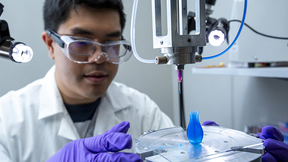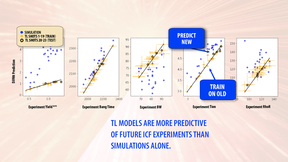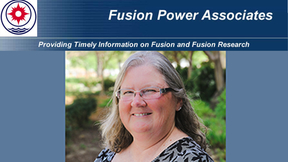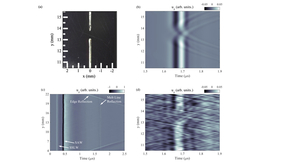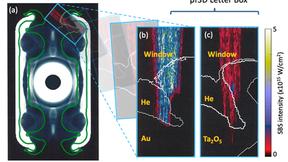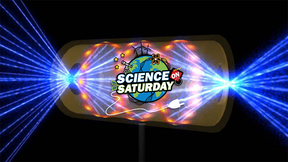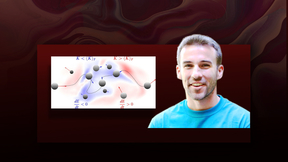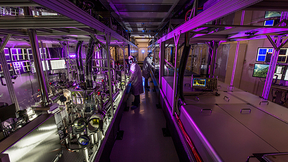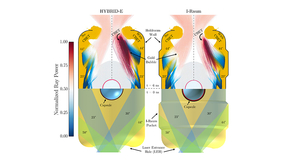Back
Lawrence Livermore National Laboratory (LLNL) scientists and engineers have garnered three awards among the top 100 industrial inventions worldwide. The trade journal R&D World Magazine recently announced the winners of the awards, often called the “Oscars of invention,” recognizing new commercial products, technologies and materials that are available for sale or…
Lawrence Livermore National Laboratory (LLNL) researchers have designed a compact multi-petawatt laser that uses plasma transmission gratings to overcome the power limitations of conventional solid-state optical gratings. The design could enable construction of an ultrafast laser up to 1,000 times more powerful than existing lasers of the same size. Petawatt (quadrillion…
After decades of inertial confinement fusion research, a yield of more than 1.3 megajoules (MJ) was achieved at Lawrence Livermore National Laboratory’s (LLNL’s) National Ignition Facility (NIF) for the first time on Aug. 8, 2021, putting researchers at the threshold of fusion gain and achieving scientific ignition. On the one-year anniversary of this historic achievement,…
The IEEE Nuclear and Plasma Sciences Society (NPSS) announced a Lawrence Livermore National Laboratory (LLNL) team as the winner of its 2022 Transactions on Plasma Science (TPS) Best Paper Award for their work applying machine learning to inertial confinement fusion (ICF) experiments. In the paper, lead author Kelli Humbird and co-authors propose a novel technique for…
The Fusion Power Associates (FPA) Board of Directors has selected Lawrence Livermore National Laboratory (LLNL) physicist Debbie Callahan as a recipient of its 2022 Leadership Award. Callahan will receive the award at the Fusion Power Associates 43rd Annual Meeting and Symposium, Dec. 7–8, in Washington, D.C. Kathryn McCarthy of Oak Ridge National Laboratory also was…
Lawrence Livermore National Laboratory (LLNL) researchers are collaborating with the French Alternative Energies and Atomic Energy Commission, known as CEA, to help develop a cryogenic target system for the CEA’s Laser Mégajoule (LMJ). The LMJ is a laser fusion counterpart to the National Ignition Facility (NIF), now conducting experiments near Bordeaux, France. Like NIF,…
Improving our understanding of the physical characteristics of plutonium as it ages is a vital aspect of maintaining the reliability of the U.S. nuclear deterrent in the absence of underground testing. The recent installation of a new plutonium target fabrication facility at Lawrence Livermore National Laboratory (LLNL) aims to further progress toward that goal…
Lawrence Livermore National Laboratory (LLNL) researchers have developed a new all-optical ultrasound technique capable of performing on-demand characterization of melt tracks and detecting formation of defects in a popular metal 3D printing process. In a paper published by Scientific Reports, Lab researchers propose a diagnostic using surface acoustic waves (SAW),…
Lawrence Livermore National Laboratory (LLNL) researchers have refined the measurement of the gamma (γ)-to-neutron branching ratio in deuterium-tritium (D-T) fusion reactions. This reaction is a viable candidate for fusion energy, as it is known to have the largest cross section at center-of-mass energies below 500 keV. There are different branches of this reaction. These…
Recent scientific advancements in fusion, combined with increasing private investments and the urgent need to address climate change, mean the “time is now” for accelerating fusion energy commercialization, fusion experts said at a White House summit on March 17. Hosted by the White House Office of Science and Technology Policy (OSTP) and the U.S. Department of Energy (DOE…
In the National Ignition Facility (NIF), the world’s highest-energy laser system, a complex series of glass optics — including amplifiers, mirrors, wavelength converters and focusing lenses — strengthens and guides the laser light to its destination. Over the years, researchers have developed and refined these optics so they can withstand the intense energies generated by…
Lawrence Livermore National Laboratory’s decades of leadership in developing high-energy lasers is being tapped to provide a key component of a major upgrade to SLAC National Accelerator Laboratory’s Linac Coherent Light Source (LCLS). Over the next several years, LLNL’s Advanced Photon Technologies (APT) program will design and construct one of the world’s most powerful…
An international team led by scientists from the University of Oxford Department of Physics, the University of Rochester and the University of Chicago turned to Lawrence Livermore National Laboratory’s (LLNL’s) National Ignition Facility (NIF) to help unravel the inner workings of heat conduction in clusters of galaxies — the largest structures in the universe. These…
In findings that could help advance another “viable pathway” to fusion energy, research led by Lawrence Livermore National Laboratory (LLNL) physicists has proven the existence of neutrons produced through thermonuclear reactions from a sheared-flow stabilized Z-pinch device. The researchers used advanced computer modeling techniques and diagnostic measurement devices…
Research conducted at Lawrence Livermore National Laboratory (LLNL) describes a validation exercise for simple models used to understand hot-spot conditions reached in an implosion, which find good agreement when compared to a set of simulations. Progress toward ignition requires accurately diagnosing current conditions and assessing proximity metrics for implosion…
A major cost of running the National Ignition Facility (NIF) is managing and mitigating laser-induced damage to optics as the laser beams propagate to the target. Another damage mechanism stems from stimulated Brillouin scattering (SBS) as light travels back from the target and with nearly the same wavelength as the incoming light. This SBS has the potential to cause…
WHO: Lawrence Livermore National Laboratory (LLNL) scientists Derek Mariscal and Dave Schlossberg, along with teacher Tom Shefler of Granada High School, will present “Bringing Star Power to Earth: Harnessing Nuclear Fusion,” the third lecture in the 2022 virtual Science on Saturday series that highlights Energy and the Environment. WHAT: This presentation will provide an…
New research conducted at Lawrence Livermore National Laboratory (LLNL) analyzes three-dimensional particle-laden, isotropic turbulence to develop an understanding of inertial particle dynamics from a kinetic energy perspective. Particle-laden flows are found in a variety of applications such as rain droplets in clouds, wind-driven sand dune sprays, fluidized bed reactors…
Lawrence Livermore National Laboratory (LLNL) and ELI-Beamlines in the Czech Republic have reached a major agreement that will build on the relationship between the two organizations and ramp up performance of the L3-High-Repetition-Rate Advanced Petawatt Laser System (L3-HAPLS) to its full design capabilities. The Strategic Partnership Project (SPP) agreement, which was…
One of the last remaining milestones in fusion research before attaining ignition and self-sustaining energy production is creating a burning plasma. In this state, the fusion reactions themselves become the dominant source of heating in the plasma, but do not yet overcome all mechanisms of energy loss. A burning plasma state was achieved on November 2020 and February 2021…

